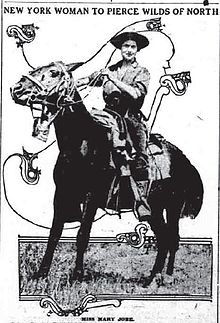Mary Jobe Akeley

Mary Jobe Akeley (born January 29, 1878 in Tappan , Ohio , † July 19, 1966 in Mystic , Connecticut ) was an American explorer, naturalist, photographer, cartographer and author. She is particularly known for her research in Africa . A mountain peak in British Columbia is named after her.
Life
Mary Jobe Akeley was the youngest daughter of Sarah Jane Jobe and Richard Watson. She attended Scio College in Alliance , Ohio, where she received her bachelor's degree in 1897 . In 1901 she began studying English and history at Bryn Mawr College . In 1909 she began studying for a Masters at Columbia University . In parallel to her studies, she taught at the City University of New York and Temple University in Philadelphia .
In 1913 she went on her first research trip to research Indian tribes in northwestern Canada . In the following years she made several trips to the Canadian Rocky Mountains , where she also made geographical , geological and botanical studies, which she documented with photographs. The Canadian government commissioned them to map the headwaters of the Fraser River . In addition, she was the first to try to climb Mount Sir Alexander , one of the highest mountains in the Canadian Rockies , which was also unmapped at the time . Because of this work she became a member of the Royal Geographical Society .
In 1914, she founded a girls' outdoor vacation camp in Mystic, Connecticut, which operated until 1930.
In 1924 she married the naturalist Carl Akeley . Together they set out on a research expedition to Africa in 1926 to explore animals and plants for the American Museum of Natural History . In what was then the Belgian Congo colony , they observed and photographed gorillas, among other things .
When Carl Akeley died unexpectedly in 1926, Mary Jobe Akeley took over the leadership of the expedition and continued his research. She also mapped entire areas of the Congo, Kenya and Tanganyika . After her return she campaigned for nature and species protection and the preservation of the habitat of indigenous peoples.
In 1935 she set off on another expedition to research animals in the Kruger National Park and the habits of the Zulu and Swazi . Between 1938 and 1941 she carried out further research in Canada; In 1947 she returned to the Kruger National Park, where she also made extensive film recordings this time.
Mary Jobe Akeley has published numerous travelogues and articles in academic journals since her first trips to Canada. She later wrote seven books on her and Carl Akeley's research in Africa.
In 1966 she died in her home in Mystic.
Publications
- 1929: Carl Akeley's Africa
- 1930: Adventures in the African Jungle
- 1932: Lions, Gorillas and Their Neighbors
- 1936: The Restless Jungle
- 1940: The Wilderness Lives Again. Carl Akeley and the Great Adventure
- 1946: Rumble of a Distant Drum. A True Story of the African Hinterland
- 1950: Congo Eden
Honors
King Albert I of Belgium awarded Mary Jobe Akeley the Order of the Belgian Crown for her services to the exploration of Africa .
The Canadian government named a peak in the Canadian Rockies Mount Jobe in her honor .
literature
- Barbara Sicherman, Carol Hurd Green: Notable American women. The modern period. A biographical dictionary, Volume 4 , Harvard University Press, Cambridge (Massachusetts) 1980, ISBN 0-674-62732-6 .
- Joyce Duncan: Ahead of Their Time. A Biographical Dictionary of Risk-taking Women , Greenwood Press, Westport 2002, ISBN 0-313-31660-0 .
Individual evidence
- ↑ GPV Akrigg, Helen B. Akrigg: British Columbia placenames , Sono Nis Press, 1986, pp 126th
| personal data | |
|---|---|
| SURNAME | Akeley, Mary Jobe |
| ALTERNATIVE NAMES | Akeley, Mary Lee Jobe; Jobe, Mary Leonore (maiden name) |
| BRIEF DESCRIPTION | American explorer, naturalist, photographer, cartographer, and author |
| DATE OF BIRTH | January 29, 1878 |
| PLACE OF BIRTH | Tappan , Ohio |
| DATE OF DEATH | July 19, 1966 |
| Place of death | Mystic , Connecticut |